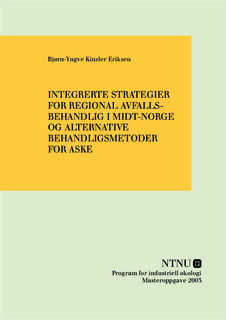| dc.contributor.author | Eriksen, Bjørn-Yngve Kinzler | nb_NO |
| dc.date.accessioned | 2014-12-19T12:34:52Z | |
| dc.date.available | 2014-12-19T12:34:52Z | |
| dc.date.created | 2007-02-27 | nb_NO |
| dc.date.issued | 2003 | nb_NO |
| dc.identifier | 122135 | nb_NO |
| dc.identifier.uri | http://hdl.handle.net/11250/242619 | |
| dc.description.abstract | In this study a model for regional waste management in Central Norway is presented, with a special focus on challenges and different disposal strategies concerning waste incineration residues, such as bottom ash, fly ash and filter cake from flue gas cleaning systems. The main objective of this study is evaluating the total environmental performance of different waste incineration and ash disposal strategies, using a combined material flow accounting (MFA) and life cycle assessment (LCA) methodology.
Different incineration technologies, and technology-specific performance regarding residues generation, are presented. Properties of different incineration residues, existing ash disposal strategy for the region and different alternative ash treatment strategies are also presented and discussed.
An existing waste model for Central Norway is expanded to also include the amounts and flows of incineration residues generated in the region. The chemical composition of the residues is also accounted for. This dynamic waste model describe the development in waste generation and incineration residues generation, and is used as a basis for the further development of scenarios.
To different scenarios are developed for waste incineration and residues disposal for the region; a centralized waste incieration scenario with disposal of incinerator ashes to landfills (Scenario A), and a decentralized waste incineration scenario with regional vitrification of the incineration residues (Scenario B). These two scenarios’ potential environmental impacts are compared using life cycle assassment methodology. The timespan of this assessment starts in year 2002 and ends in 2020.
The results from this assessment show that Scenario B clearly has the lowest overall potential for environmental impacts. The results also show that the impacts from the subprocesses connected to the residuals downstreams from the incineration, are of minor importance to the total impacts. An exception here is the impact category “terrestrial ecotoxicity”, where landfilling of bottom ash is the dominant contributor for the total impact potential for this impact category.
The subprocesses connected to the residuals disposal/treatment for both scenarios have also been compared separately. This comparison showed that it is difficult to say which of the two residual strategies that has the best overall environmental performance. The landfilling strategy in Sceanrio A causes highest potential impacts for certain impact categories such as “terrestrial ecotoxicity” and “eutrophication”, while the vitrification strategy causes highest potential impacts for other impact categories such as “global warming potential” and “acidification”. A change in the residuals treatment strategy will thus not necessarily reduce the total potential for environmental harm, but instead change the main impacts from one impact category to another - a situation often reffered to as “problem shifting”. | nb_NO |
| dc.language | nor | nb_NO |
| dc.publisher | Institutt for energi- og prosessteknikk | nb_NO |
| dc.title | Integrerte strategier for regional avfallsbehandlig i Midt Norge og alternative behandligsmetoder for aske | nb_NO |
| dc.type | Master thesis | nb_NO |
| dc.contributor.department | Norges teknisk-naturvitenskapelige universitet, Fakultet for ingeniørvitenskap og teknologi, Program for industriell økologi | nb_NO |
